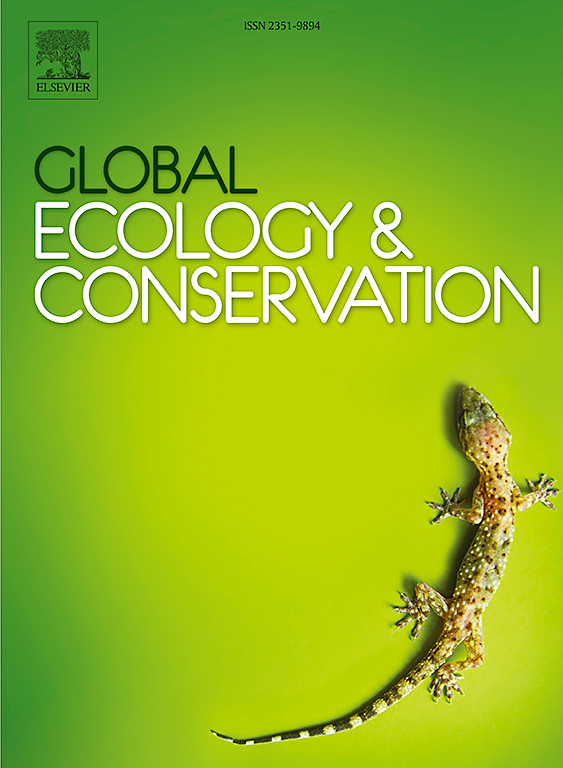谁在何时何地活跃?揭示捕食者-人类共同景观中猎物的栖息地使用和时间策略
IF 3.4
2区 环境科学与生态学
Q1 BIODIVERSITY CONSERVATION
引用次数: 0
摘要
了解主要猎物物种的栖息地利用和时间活动模式对于保护大型食肉动物(如老虎和豹子)至关重要,特别是在人类主导的景观中。因此,本研究调查了尼泊尔班克国家公园(BaNP)六种主要猎物物种与捕食者和人类的栖息地关联和饮食活动重叠。为此,我们沿着2 公里× 2 公里的网格部署了相机陷阱(n = 30),总共花费了450个陷阱夜的采样时间。广义线性混合模型用于揭示物种特有的生境关联。吠鹿被发现与植被稀少和靠近水的地区有关,同时避开道路;相比之下,斑点鹿对人类干扰的耐受性更高。类似地,四角羚羊避开陡坡,野猪在公路附近不常见,印度冠豪猪喜欢低干扰的地区。时间活动分析表明,猎物的活动模式多样,从黄昏到夜间,大多数物种表现出与捕食者活动的适度重叠。斑鹿和四角羚羊的时间同步减少支持了人类盾牌假说,表明这些物种改变了它们的活动,以应对人类增加的存在,以减轻被捕食的风险。相反,捕食者会尽量减少与人类的时间重叠,这可能是一种避免相遇的适应策略。这些发现表明,有必要对特定物种的栖息地进行管理,以维持猎物数量并减轻人类与野生动物的冲突。我们建议进行进一步的研究,以收集全年的数据,从而全面了解季节变化如何影响研究区域和类似景观中猎物及其捕食者的活动。本文章由计算机程序翻译,如有差异,请以英文原文为准。
Who’s active when and where? Unraveling the habitat use and temporal strategies of prey in a predator-human shared landscape
Understanding the habitat use and temporal activity patterns of key prey species is crucial for conserving large carnivores, such as tigers and leopards, especially in landscapes dominated by humans. Hence, this study investigated the habitat associations and diel activity overlaps of six major prey species with both predators and humans in Banke National Park (BaNP), Nepal. For this, we deployed camera traps (n = 30) along a 2 km × 2 km grid, resulting in a total sampling effort of 450 trap nights. Generalized linear mixed models were used to reveal species-specific habitat associations. Barking deer were found associated with areas of sparse vegetation and proximity to water while avoiding roads; in contrast, spotted deer tolerated higher levels of human disturbance. Similarly, four-horned antelopes avoided steep slopes, wild boars were less common near roads, and Indian crested porcupines preferred regions with low disturbance. Temporal activity analyses indicated diverse activity patterns among prey, ranging from crepuscular to nocturnal, with most species exhibiting moderate overlap with predator activity. The reduced temporal synchrony noted for spotted deer and four-horned antelopes supports the human shield hypothesis, suggesting that these species alter their activity in response to increased human presence to mitigate predation risk. Conversely, predators minimized their temporal overlap with humans, likely as an adaptive strategy to avoid encounters. These findings signify the necessity for species-specific habitat management to sustain prey populations and mitigate human-wildlife conflict. We recommend conducting further studies to gather year-round data that will provide a thorough understanding of how seasonal changes influence the activities of prey and their predators in the study area and similar landscapes.
求助全文
通过发布文献求助,成功后即可免费获取论文全文。
去求助
来源期刊

Global Ecology and Conservation
Agricultural and Biological Sciences-Ecology, Evolution, Behavior and Systematics
CiteScore
8.10
自引率
5.00%
发文量
346
审稿时长
83 days
期刊介绍:
Global Ecology and Conservation is a peer-reviewed, open-access journal covering all sub-disciplines of ecological and conservation science: from theory to practice, from molecules to ecosystems, from regional to global. The fields covered include: organismal, population, community, and ecosystem ecology; physiological, evolutionary, and behavioral ecology; and conservation science.
 求助内容:
求助内容: 应助结果提醒方式:
应助结果提醒方式:


